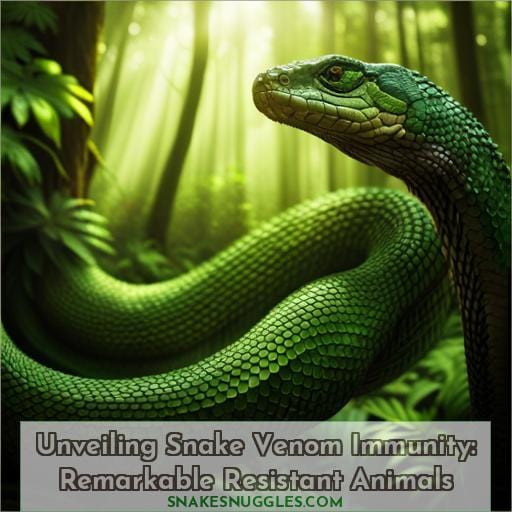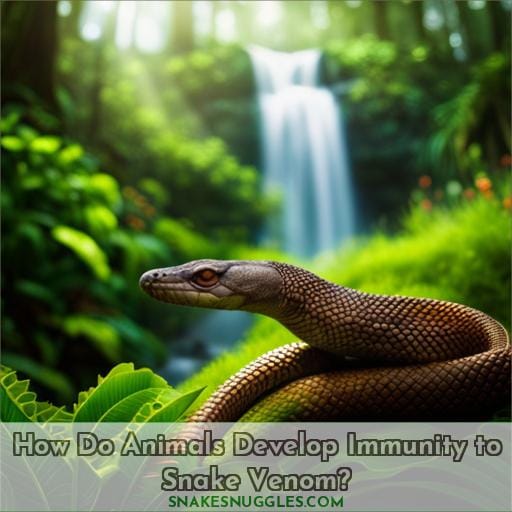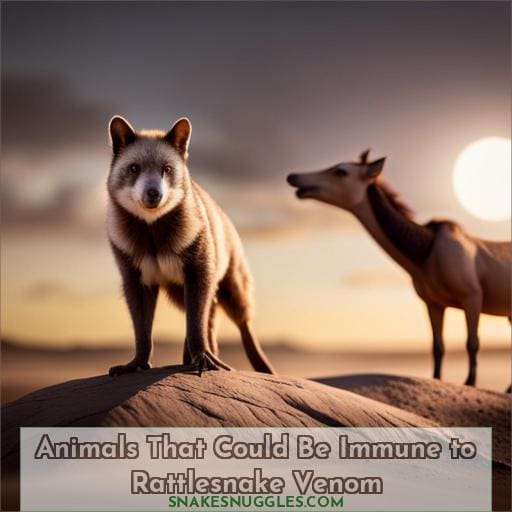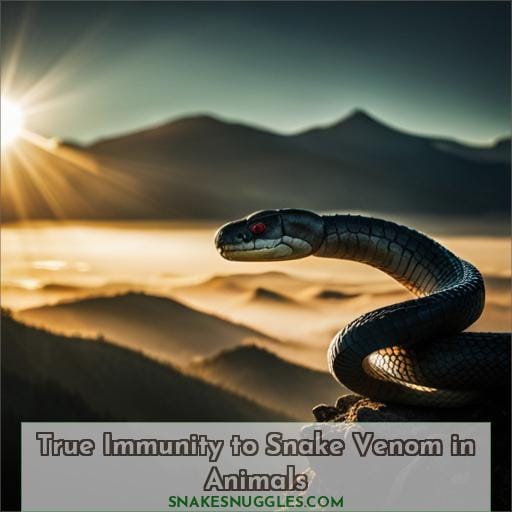This site is supported by our readers. We may earn a commission, at no cost to you, if you purchase through links.

Let’s explore this fascinating topic further by delving into the science behind animal immunity to snake venom.
Venomous vs poisonous: what are the differences between them? We’ll also take a look at why certain animals might be immune to rattlesnake poison – hedgehogs perhaps?! Finally, we’ll examine true venoms-resistance versus complete immutability among our studied subjects.
Table Of Contents
Key Takeaways
- Woodrats, opossums, and California ground squirrels possess immunity to snake venom.
- Kingsnakes and indigo snakes exhibit adaptations that enable them to prey on venomous species.
- Hedgehogs and honey badgers have developed physical and genetic defenses against venomous snakes.
- Mongooses have mutated acetylcholine receptors, reducing the potency of snake venom.
Animals Immune to Snake Venom
You may be surprised to learn that there are several species of animals which have evolved immunity to snake venom. Woodrats, kingsnakes, eastern indigo snakes, California ground squirrels, and opossums all possess natural defenses against the bites of rattlesnakes.
Furthermore, they have adapted their behavior in order to coexist with these deadly predators as a part of their evolutionary journey.
Woodrats
You may not know it, but woodrats are known to have a natural immunity to rattlesnake venom! Woodrats possess an evolutionary adaptation that prevents the binding of peptides present in snake venom. This helps protect them from predators while also providing them with food sources they would otherwise be unable to consume.
Additionally, genetic mutations provide woodrat populations with increased immunity compared to other species in their environments. Adaptations such as these help ensure survival and promote reproductive success for future generations of animals immune to snake venom.
Kingsnakes
See how kingsnakes slither around rattlesnakes, safe from their venomous bites? Kingsnake feeding habits and coloration serve as both camouflage and a warning signal. They play an important role in the ecosystem as predators of other snakes, such as rattlesnakes.
Hunting techniques vary by species but include locating prey through smell or sight before striking with lightning speed to inject venom that quickly immobilizes them. Their preferred diets are small mammals like mice or lizards, but they also feed on eggs and carrion when necessary for survival.
Kingsnakes offer insight into animals’ immunity to snake venom due to their innate resistance against most North American pit viper venoms – making them one of nature’s greatest marvels!
Indigo Snakes
Marvel at the incredible indigo snakes, gifted with an innate immunity to rattlesnake venom! These reptiles exhibit impressive behaviors, such as preying on other venomous species and utilizing peptides found in snake venoms.
This allows them to benefit from evolutionary advantages while limiting their own risk of injury or death. Indigo snakes also possess specialized enzymes that can neutralize toxins present in the snake’s saliva, providing further protection against bites from poisonous predators.
As a result, these animals have developed a remarkable defense system that has allowed them to survive and thrive despite being surrounded by danger.
California Ground Squirrel
Discover how the California Ground Squirrel has adapted to its environment, making it immune to rattlesnake venom. By chewing on snake skin for camouflage, the ground squirrel is able to remain safe and protected from predators in spite of the danger that lurks nearby.
Its resistance mechanism involves producing peptide neutralizing pit viper venom as well as developing genetic immunity through serum factors and molecular changes. This evolutionary advantage allows them access to an extended food source while providing protection against potentially fatal bites from snakes – a benefit unseen in other species without such adaptations.
The research into this behavior provides insight into antivenom production and furthers our understanding of predator-prey interactions between animals with varying levels of venom defense strategies.
Opossums
Uncover the remarkable adaptive traits of opossums, which produce peptides to neutralize pit viper venom. The nocturnal marsupials have evolved true immunity to snake bites thanks to their unique cell mutation that releases a venom-neutralizing peptide upon contact with the toxin.
This allows them not only to survive a bite but also recover from it quickly and without suffering long-term effects.
Opossums’ immune factors enable them to successfully respond and adapt when faced with such potent venoms – an impressive feat by any standard! With this evolutionary adaptation, they are well equipped for life in areas where venomous snakes are common predators.
How Do Animals Develop Immunity to Snake Venom?
It is a remarkable fact that many animals have developed immunity to snake venom, from thick-skinned honey badgers and meerkats to those with genetic mutations like pigs that have evolved to counter venomous snake bites
. This extraordinary capability has been extensively studied by scientists employing a scientific precision, interdisciplinary approach in order to gain insight into how surviving a snake bite can be achieved through venom resistance.
Thick Skin
Experience the amazing ability of certain animals to protect themselves from snake venom with thick skin! Thick skin helps predators that prey on venomous snakes, such as woodrats, kingsnakes, and indigo snakes.
These animals have evolved skin adaptations like natural armor and dermis resilience, which provide a protective epidermis against their predator’s venom. This evolutionary advantage allows them to resist deadly toxins while still having the freedom to hunt for food safely, without fear of harm.
In addition, this resistance mechanism is also an effective deterrent for other potential predators looking for a quick meal.
Surviving a Snake Bite
Behold as you witness animals surviving a snake bite with remarkable immunity. Animals such as hedgehogs and mongoose have developed resistances through unique serum factors and molecular changes. Woodrats, kingsnakes, indigo snakes, ground squirrels, and opossums have all evolved ways to inhibit binding enzymes or protect against neurotoxins found in venom.
Venom Resistance
Discover how some predators have adapted to rattlesnake venom with natural defenses and evolutionary adaptations. Take the woodrats, for example: their immunity was discovered in 1976 at Texas A&M when they bit a rattlesnake without harm! Kingsnakes inhibit venom-binding enzymes; indigo snakes are immune to North American varieties.
California ground squirrels resist rattlesnake poison, even adapting their behavior by chewing on snake skin for camouflage against other predators.
These incredible adaptations offer insight into medical implications of snakebite protection as well as coevolutionary arms races between species.
Venomous Vs. Poisonous: What’s the Difference?
Marvel at the contrast between venomous and poisonous, two distinct methods of noxious delivery! While a bite from a venomous creature injects toxins into the victim’s bloodstream, poisons are usually absorbed through skin contact or ingestion.
Venom-wielding predators pose an especially troublesome threat – Ronald’s rule states that Bite and die for poison; bite and you die for venom. Humans have developed relative resistance to many poisons over time due to evolutionary arms races with toxic prey adaptations, but animals such as woodrats, kingsnakes, mongoose species, or opossums have evolved much more impressive mechanisms to resist dangerous venoms.
These range from enzyme inhibition in kingsnakes that allows them to consume other snakes safely all the way up complex genetic mutations like those found in some pigs which prevent binding of neurotoxins typically found in snake venoms! Predators may also use their immunity as a deterrent against potential threats by chewing on snake skins – California ground squirrels do this alongside being immune rattlesnake bites themselves!
This incredible diversity of defense mechanisms is testament both nature’s ability to evolve quickly when necessary and our own desire to understand these processes so we can apply them towards medical treatments too.
Animals That Could Be Immune to Rattlesnake Venom
It is remarkable that some animals have the ability to resist rattlesnake venom, such as hedgehogs, honey badgers, and mongooses. With scientific precision and an interdisciplinary approach, this article will explore how these creatures are able to fight off the dangerous effects of venomous bites from snakes.
Hedgehog
Experience the remarkable evolutionary adaptation of hedgehogs, who possess tough skin and genetic immunity to Elapidae venom! Hedgehogs have adapted natural defenses that allow them to resist snake venom proteins.
Their resistant mechanisms are achieved through serum factors and molecular changes in their bodies.
Meerkats and members of the mongoose family have also developed resistance to snake venom due to similar adaptations. These adaptations involve a mutated acetylcholine receptor that causes the venom molecules to bounce off muscle cells.
Venom resistance increases the hedgehog’s food options as well as their reproductive success. It is a key element of their survival against predators such as snakes, while also allowing them to prey on others for sustenance.
Honey Badger
You’ve heard of the hedgehog’s immunity to snake venom, but have you ever seen a honey badger in action? With tough skin and genetic resistance to Elapidae snakes, even their own toxins can bounce off its muscle cells.
By exploring powerful predators like this one, we gain insight into the fascinating world of toxin exploration. The honey badger is an expert at surviving – adapting its diet and behavior accordingly for maximum protection against venomous snakes’ predation within its ecosystem.
Mongoose
Discover how mongooses have developed resistance to venom thanks to their mutated acetylcholine receptors. Mongooses possess the ability to hunt and eat venomous snakes, a trait that is attributed in part to genetic mutations that allow them immunity from snakebite.
These adaptations enable the mongoose’s muscle cells to resist absorption of toxins present in some species’ venoms, allowing it freedom and safety when hunting its prey. Meerkats are another example of an animal with similar toxin-resistant abilities, suggesting such traits may be common among certain members of this family.
The coexistence between these predators and their prey offers fascinating insight into natural defenses against deadly poisons—one that could provide new antivenom treatments for humans as well!
True Immunity to Snake Venom in Animals
Many animals have developed natural defenses to avoid the effects of venomous snakes. While some species may be resistant to venom, true immunity is rare and requires specific evolutionary adaptations.
Humans can learn from these unique traits to create antivenoms that could save lives in the future.
Causes of Immunity
Amaze yourself by learning how certain animals have acquired immunity to rattlesnake venom! Natural selection has enabled some species to develop immunological mechanisms against the toxin cocktails found in snakebites.
For example, woodrats and kingsnakes inhibit venom-binding enzymes; eastern indigo snakes are immune to North American rattlesnake bites; California ground squirrels resist the poison through their genetic makeup and adaptability.
Evolutionary adaptations such as these provide insight into potential antivenom solutions while furthering our understanding of cross-species comparisons in terms of animal defenses against predation.
Venom-Resistant Vs. Venom-Immune Animals
Different animals have evolved an array of defenses to survive against snake venom, ranging from enzyme inhibition to genetic mutations. These mechanisms provide variability in predator deterrents and toxin exploration for ecological balance as well as an evolutionary advantage.
From woodrats’ immunity to North American rattlesnakes, hedgehogs’ serum factors neutralizing Elapidae venom, or mongoose’s mutated acetylcholine receptors deflecting muscle cells, each adaptation has its own significance.
Furthermore, understanding these unique immunities can lead to medical applications providing safety and freedom from the dangers of snake bites.
Conclusion
It is estimated that nearly three thousand species of snakes exist in the world, many of which are venomous. Despite this, some animals have evolved to be immune to snake venom, such as woodrats, kingsnakes, and indigo snakes, among others.
These animals have developed a variety of ways to defend themselves, including thick skin, surviving a snake bite, and true venom resistance.
While venomous and poisonous are often used interchangeably, they refer to two distinct traits; venom is injected and poison is absorbed, inhaled, or ingested. Scientists are still studying the evolution of venom resistance in animals and the implications of this research.
It is clear that animals immune to snake venom have evolved an impressive array of defense mechanisms, and this research could lead to important medical applications.











